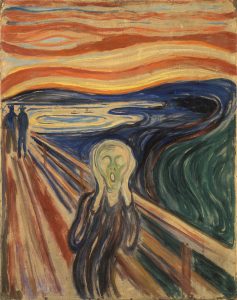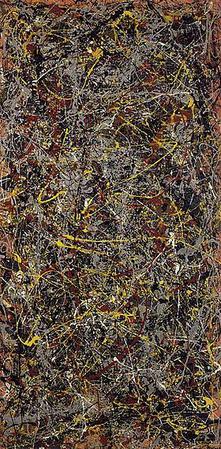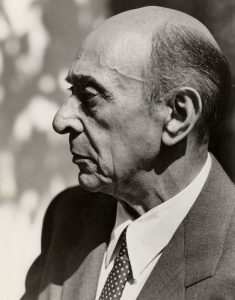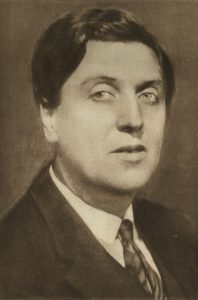3. Expressionism and Serialism
While the Impressionist composers attempted to move further away from Romantic forms and Romantic harmony, some Expressionist composers succeeded in completely eliminating harmony and tonal melody (melody based on a particular key) from their music. The resultant sounds were often not very melodically and harmonically pleasant to hear and therefore, the Expressionist style of music did not (and still does not) appeal to the majority of audiences. The name of this style period can be confusing for some. The Expressionist period was not a time when composers sought to express themselves emotionally in a romantic, beautiful, or programmatic way. Due to the nature of the sounds produced by the system of composition described below, Expressionism seems more appropriate for evoking more extreme, and sometimes even harsh, emotions. Using this experimental style of writing, composers such as Arnold Schoenberg (1874–1951) attempted to intentionally eliminate what we call tonality—music that is based on scales and the progression (movement) of chords from one to another.

In Edward Munch’s famous painting, The Scream (Figure 7.3), we see an excellent example of the parallel movement of expressionism taking place in the visual arts. Expressionists looked inward, specifically to the anxiety they felt towards the outside world. This was in stark contrast to the impressionists, who looked to the beauty of nature for inspiration. Expressionist paintings relied instead on stark colors and harsh swirling brushstrokes to convey the artist’s reaction to the ugliness of the modern world. Abstract Expressionism took this concept to a greater extreme, by abandoning shape altogether for pure abstraction. This style is typified by the works of the American painter Jackson Pollock (Figure 7.4).

Many of the early works of Arnold Schoenberg (1874–1951) exemplified an expressionistic musical style. He is most famous for his experiments with atonality, that is, music without a tonal center. His music was highly dissonant and sounded quite radical when compared to earlier music, which utilized dissonance only as a means to eventually return to the stasis of consonance. Schoenberg saw dissonance not as a means to an end, but as the end itself. His music invited the listeners to revel in various levels of dissonance, and many were never able to adjust.
Born in Austria, and of Jewish descent, Schoenberg was already composing by the age of nine. While in his teens, he studied composition with the Austrian composer and conductor Alexander Zemlinsky. In 1901 he moved to Berlin where he was befriended and mentored by the German composer Richard Strauss. Three years later in 1903, Schoenberg returned to Austria and began a long association with the renowned composer Gustav Mahler who became one of his strongest supporters.

In 1909, Schoenberg composed the first complete work that completely did away with tonality. This piano composition was one of three that together are listed as his Opus 11 and was the first piece we now refer to as being completely atonal (without tonality). Schoenberg’s most important atonal compositions include: Five Orchestral Pieces (1909), Pierrot Lunaire (Moonstruck Pierrot, 1912), Die Jakobsleiter (Jacob’s Ladder, 1917, unfinished), Die glückliche Hand (The Lucky Hand, 1924), and Erwartung (Expectation, 1924) for soprano and orchestra.
Schoenberg famously developed a system whereby the twelve notes of the chromatic scale were randomly organized into scale units that he called the twelve-tone row. These rows could then be further “serialized” (organized in random fashion) by a number of different techniques. This idea of assigning values to musical information is called serialism. In 1921 Schoenberg composed his Suite for Piano Op. 25, the first composition written using the 12-tone method. Each 12-tone composition is built from a series of 12 different pitches that may be arranged in a number of different ways. The original row may be played forwards, backwards (retrograde), upside down (inverted), and backwards and inverted (retrograde inversion). All of the melodies and harmonies in a 12-tone piece must be derived in some way from the original row or from fragments of the original row.
In 1925 Schoenberg was hired by the Prussian Academy of Arts in Berlin to teach composition, and he would most likely have continued his career as teacher and composer in Europe were it not for the rise of the Nazi party and their subsequent persecution of European Jews. In 1933 he resigned from the Academy and moved first to Paris and then to Boston. In 1934 he settled in California and held teaching positions first at the University of Southern California (1935–36) and then the University of Central Los Angeles (1936–44).
Focus Composition: A Survivor from Warsaw by Arnold Schoenberg
After immigrating to the United States, Schoenberg reconnected with the Jewish faith he had abandoned as a young man. The sadness he felt because of the personal accounts of the horrible treatment experienced by so many Jews during World War II led to his composition of A Survivor from Warsaw, which was composed for orchestra, male chorus, and a narrator. The piece was entirely built on a twelve-tone row and was completed in September 1947. This important work is Schoenberg’s dramatization of a tragic story he heard from surviving Polish Jews who were victims of Nazi atrocities during World War II. Schoenberg created a story about a number of Jews who survived the war by living in the sewers of Warsaw. Interestingly, among Schoenberg’s many and very specific performance instructions is the request that the narrator not attempt to sing his part throughout the performance.
Listening Guide
Bamberger Symphoniker, conducted by Horst Stein; Hermann Prey, narrator
Composer: Arnold Schoenberg (1874–1951)
Composition: A Survivor from Warsaw
Date: 1947
Genre: 12-tone composition for orchestra, male chorus, and a narrator
Form: through-composed
Nature of Text: original text for narrator in English and German; text for chorus in Hebrew (Jewish prayer Shema Yisrael)
Performing Forces: orchestra, male chorus, and a narrator
| Timing | Performing Forces, Melody, and Texture |
| 0:35 | Trumpet introductory fanfare; snare drum and clarinets; irregular rhythmic figures; 12-tone chordal structures |
| 0:46 | Cellos enter with rhythmic motif. Brief melodic motifs move between cellos, woodwinds, trumpets, and strings. Rhythms are irregular. 12-tone based chordal structures continue. |
| 1:06 | Xylophone added |
| 1:15 | Clarinet added, completing the instrumental introduction |
| 1:21 | Narration starts. Instrumentation and dynamics are altered to match rise and fall of phrases in narration. |
| 1:57 | French Horn enters. |
| 2:19 | Narration becomes much more intense and trumpet fanfare underscores this change. |
| 3:09 | Bass drum begins a steady pulse with snare drum and xylophone with irregular rhythms as drama in the narration increases. |
| 3:20 | Narration switches to German, shouting: “Achtung! Stilljestanden! Na wird’s mal! Oder soll ich mit dem Jewehrkolben nachhelfen? Na jut; wenn ihrs durchaus haben wollt!” (“Attention! Stand still! How about it, or should I help you along with the butt of my rifle? Oh well, if you really want to have it!”) |
| 3:36 | Narration switches back to English. Strings play tremolo in the background. |
| 4:00 | Narration becomes more introspective. Strings become more lyrical to underscore the change in story. |
| 4:20 | Orchestra’s interlude decreases the intensity of the moment. |
| 4:37 | Narration resumes. …… “Abzählen!” (“Count off!”) … “Achtung!” (“Attention!”) … “Rascher! Nochmals von vorn anfange! In einer Minute will ich wissen, wieviele ich zur Gaskammer abliefere! Abzählen!” (“Faster! Once more, start from the beginning! In one minute I want to know how many I am going to send off to the gas chamber! Count off!”) |
| 6:00 | As narrator says “faster and faster,” the music begins to accelerate as well. |
| 6:19 | Chorus begins to sing the Jewish prayer Shema Yisrael accompanied by strings. Brass and woodwinds are used as interjections throughout this section. “Shema Yisrael, Adonai Eloheinu, Adonai Echad. V’ahavta eit Adonai Elohecha b’chawl l’vav’cha uv’chawl nafsh’cha, uv’chawl m’odecha. V’hayu had’varim haeileh, asher anochi m’tsav’cha hayom, al l’vavecha. V’shinantam l’vanecha, v’dibarta bam b’shivt’cha b’veitecha, uvlecht’cha vaderech, uv’shawchb’cha uvkumecha. Ukshartam l’ot al yadecha, v’hayu l’totafot bein einecha. Uchtavtam, al m’zuzot beitecha, uvisharecha.” (“Hear, O Israel, the Lord is our God, the Lord is One. You shall love the Lord your God with all your heart, with all your soul and with all your might. And these words which I command you today shall be on your heart. You shall teach them thoroughly to your children, and you shall speak of them when you sit in your house and when you walk on the road, when you lie down and when you rise up. You shall bind them as a sign upon your arm, and they shall be for a reminder between your eyes. And you shall write them upon the doorposts of your house and upon your gates.”)Brass and percussion join the chorus. Intensity in the chorus and orchestra build. |
| 7:52 | Brass and strings continue as chorus ends, building to the big climactic moment to conclude piece. |

Schoenberg’s ideas were further developed by his two students, Alban Berg (1885–1935) and Anton Webern (1883–1945). Together, the three came to be known as the Second Viennese School, in reference to the first Viennese School, which consisted of Haydn, Mozart, and Beethoven. Born in Vienna, Alban Berg began studying with Schoenberg at the age of 19 and soon became known for his unique compositional style, which fused post-romantic concepts with Schoenberg’s cutting edge twelve-tone techniques. Heavily influenced by Richard Wagner, Berg held on to techniques such as the leitmotif and sought to couch his harmonic ideas in tried-and-true forms such as the sonata and fugue. Although he composed many notable pieces, such as his Violin Concerto and his unfinished opera Lulu, he initially made his fame with Wozzeck, an opera based on the drama Woyzeck by German playwright Georg Buchner. Berg served during World War I, and much of Wozzeck was composed in 1917, during a period of leave from the Austro-Hungarian Army. The opera consists of three acts, each with five scenes organized around the variations of a musical idea, such as the variations of a theme, a chord, or a rhythmic pattern. Berg himself adapted the libretto from Buchner’s original play.
Focus Composition: Act III, Scene 2, from Wozzeck by Alban Berg
The story of the opera centers on the title character Wozzeck. Like the main character in many romantic operas, he is a tragic figure. However, whereas the operas of the 19th century often depicted gods and mythical figures, the story of Wozzeck is couched in a sense of realism and addresses the type of societal problems that Berg may himself have encountered during World War I, such as apathy and human cruelty. The character of Wozzeck is that of a pitiful and unremarkable soldier who is tormented by his captain, and used for and subjected to medical experiments by a sadistic doctor. Wozzeck, who is often given to hallucinations, eventually goes mad and kills his love interest, Marie, who has been unfaithful. The opera ends after Wozzeck drowns, trying to clean the murder weapon in a pond and wading out too far.
Listening Guide
Film production of Wozzeck; the Hamburg Philharmonic State Orchestra and the Chorus of the Hamburg State Opera, conducted by Bruno Maderna and directed for television by Joachim Hess; baritone Toni Blanenheim as Wozzeck; soprano Sena Jurinac as Marie
Composer: Alban Berg (1885–1935)
Composition: Wozzeck
Date: premiered in 1925
Genre: a scene from an opera
Form: variations on a single note “B”
Nature of Text: original text in German
The Scene: Act III, Scene 2. Wozzeck and Marie walk by a pond. Wozzeck stabs Marie in throat with a knife.
Performing Forces: baritone, soprano, and orchestra
| Timing | Performing Forces, Melody, and Texture | Text |
| 0:00 | Instrumental introduction evoking a low, and ominous feeling. | |
| 0:24 | Wozzeck and Marie enter. Marie wishes to leave. A syrupy melody in the strings reflects Wozzeck’s pleas to Marie to sit down. Marie leaps up, saying, “I must go!” |
Marie: Dort links geht’s in die Stadt. ‘s ist noch weit. Komm schneller! Wozzeck: Du Sollst dableiben, Marie. Kom, setz’ Dich. Marie: Abe rich muss fort. Wozzeck: Komm. |
| 0:44 | Low ominous notes play underneath as Wozzeck lures her back. | Wozzeck: Bist weit gegangen, Marie. Sollst Dir die Fusse nicht mehr wund laufen. ‘s ist still hier! Und so dunkel. – Weisst noch, Marie, wi lang’ es jetzt ist, dass wir uns kennen? Marie: Zu Pfingsten drei Jahre. Wozzeck: Und was meinst, wie lang’ es noch dauern wird? Marie: Ich muss fort. Wozzeck: Furchst Dich, Marie? Und bist doch fromm! Und gut! Und true! |
| 2:03 | A sweet melody in the strings evokes the line by Wozzeck “What sweet lips you have, Marie.” | Wozzeck: Was Du fur susse Lippen hast, Marie! Den Himmel gab’ ich drum und die Seligkeit, wenn ich Dich noch of so kussen durft! Abe rich darf nicht! Was zitterst? |
| 2:57 | Wozzeck says, “Those who are cold shiver no more. You will not shiver in the morning dew,” foretelling Marie’s death. She asks what he means and the music ceases creating a tense silence. | Marie: Der Nachttau fallt. Wozzeck: Wer kalt ist, den friert nicht meher! Dich wird beim Morgentau nicht frieren. Marie: Was sagst Du da? Wozzeck: nix. |
| 3:29 | The music begins to build as Wozzeck prepares to kill Marie. | Marie: Wie der Mond rot aufgeht! Wozzeck: Wie ein blutig Eisen! Marie: Was zitterst? Was Willst? |
| 4:07 | The music echoes Wozzeck word by word as he says, “No one, Marie! If not me, then no one!” After the act is done, the orchestra dies down to a single note and Wozzeck exclaims, “Dead!” | Wozzeck: Ich nicht, Marie! Und kein Andrer auch nicht! Marie: Hilfe! Wozzeck: Tot! |
Composing music using a series of values assigned to musical elements such as pitch, duration, dynamics, and instrumentation. Arnold Schoenberg’s 12-tone technique is one of the most important examples of serialism.
The text or actual words of an opera, musical, cantata, or oratorio, written or compiled by a librettist.
